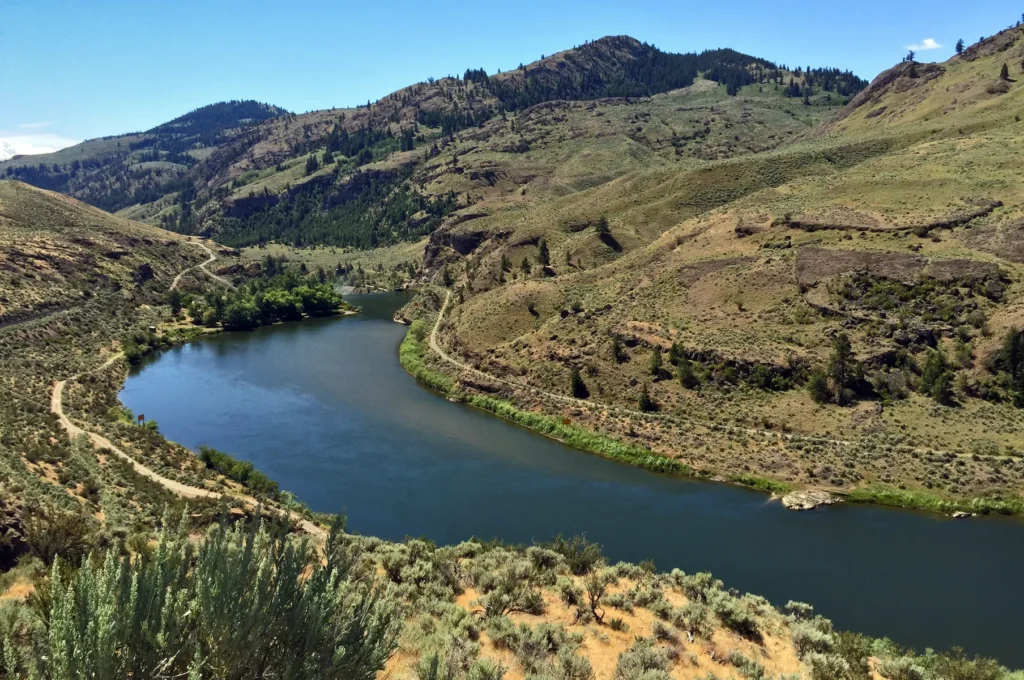

 Similkameen River & Pacific Northwest Trail. Photo: Greg Shine
Similkameen River & Pacific Northwest Trail. Photo: Greg Shine
How can the exercise of global indigenous sovereignty counter the growing destruction caused by the climate crisis?
A 2012 interview with CWIS founder Dr. Rudolph Rÿser, republished in our most recent issue of the Fourth World Journal, outlines the critical roles of tribal governance and cultural preservation in environmental justice. “Asserting Native Resilience: Pacific Rim Indigenous Nations Face the Climate Crisis” argues that Indian Nations must leverage their autonomy within climate negotiations to assert their cultural and environmental sovereignty over tribal lands.
As Former United Nations General Assembly President Abdulla Shahid has pointed out, Indigenous Peoples comprise less than 5 percent of the global population yet protect 80 percent of global biodiversity. Yet, indigenous land remains vulnerable to corporate encroachment, resource extraction, and human-induced climate change. Furthermore, as Rÿser emphasizes, even in cases of state-recognized indigenous autonomy, “how are they going to deal with somebody who is spewing smoke out 48 miles away and off your territory?” Thus, a framework must be created for intertribal cooperation within the world system based on the synthesis of Western and Native sciences.
In the interview, Rÿser speaks on the dominance of the European scientific method of creating sustainable climate policy. The United States has historically obscured popular participation in environmental negotiations by overemphasizing the technical and scientific aspects of solution-making. The “objectivity” granted exclusively to Western science obfuscates the subjectivities and lived experiences of those most affected by the climate crisis. Yet, another path is possible―integration without hegemony. With Western and Native sciences combined toward cooperative environmental solutions, we can hope for a cleaner and better future.
When this interview was initially conducted, The Quinault Indian Nation had recently completed the first phase of a long-term terraforming project to restore ecosystem functions in the Upper Quinault River. Through the assertion of local sovereignty, the Quinault were able to undertake this project with the cooperation of the U.S. National Park Service, Forest Service, and local property owners. Despite these efforts, “The Quinault observed that 60 yards of
their beach ha[d] eroded, and the water [was] now 60 yards closer.” Now, in 2024, the water is known to flood a 15-foot seawall, causing frequent evacuations for residents and the erosion of local infrastructure.
While immediate solutions, including emergency services, hazard relief, and public health initiatives, are urgently needed, long-lasting global infrastructure must be implemented―soon. As Rÿser explores during his discussion of the carbon trading policy, international systems have too often attempted to create solutions for climate change within the limitations of the profit incentive. Additionally, the UN’s restrictive bureaucracy and failure to take seriously the concerns of Indigenous nations has only caused further complications for fourth-world environmental advocates.
Most recently, the International Council on Mining and Metals has released a position statement skirting the international agreement of Free Prior and Informed Consent (FPIC) asserted by the UN Declaration on the Rights of Indigenous Peoples. Without the appropriate enforcement mechanisms to hold corporations accountable for their misdeeds, transnational companies will continue to exploit Indigenous land and resources for profit.
As the Asia Indigenous Peoples Network on Extractive Industries and Energy (AIPNEE) and the Right Energy Partnership with Indigenous Peoples (REP) wrote in their collective condemnation of the council’s statement, “This not only violates Indigenous Peoples’ rights but also has far-reaching consequences, including social unrest, environmental degradation, irreversible loss of cultural heritage, among others.” The assertion of Indigenous-crafted plans and policies is thus increasingly necessary to circumvent these abuses of corporate power.
Protections such as those outlined in the UN Declaration on the Rights of Indigenous Peoples exist as a result of decades of struggle on behalf of human and environmental rights advocates like Dr. Rÿser. It is now of equal importance that these existing frameworks be respected and enforced globally. States, organizations, and individuals must recognize the credibility of Indigenous science and governance should we hope to create genuine, lasting solutions to the climate crisis.
References:
United Nations Press. (2022, April 25). Extraction operations on Indigenous Peoples’ land without consent cause irreparable harm, speakers stress, as Permanent Forum begins session. https://press.un.org/en/2022/hr5467.doc.htm
Golden, H. (2024, June 12). For at least a decade Quinault Nation has tried to escape the rising Pacific. Time is running out. AP News. https://apnews.com/article/tribe-quinault-sea-level-rise-climate-change-995a69656e77ff1825ec72fa07727478
Asia Indigenous People’s Network on Extractive Industries and Energy. (2024, June 19). Indigenous groups slam ICMM’s draft mining position statement. https://aipnee.org/campaigns/indigenous-groups-slam-icmms-draft-mining-position-statement/
The library is dedicated to the memory of Secwepemc Chief George Manuel (1921-1989), to the nations of the Fourth World and to the elders and generations to come.
access here